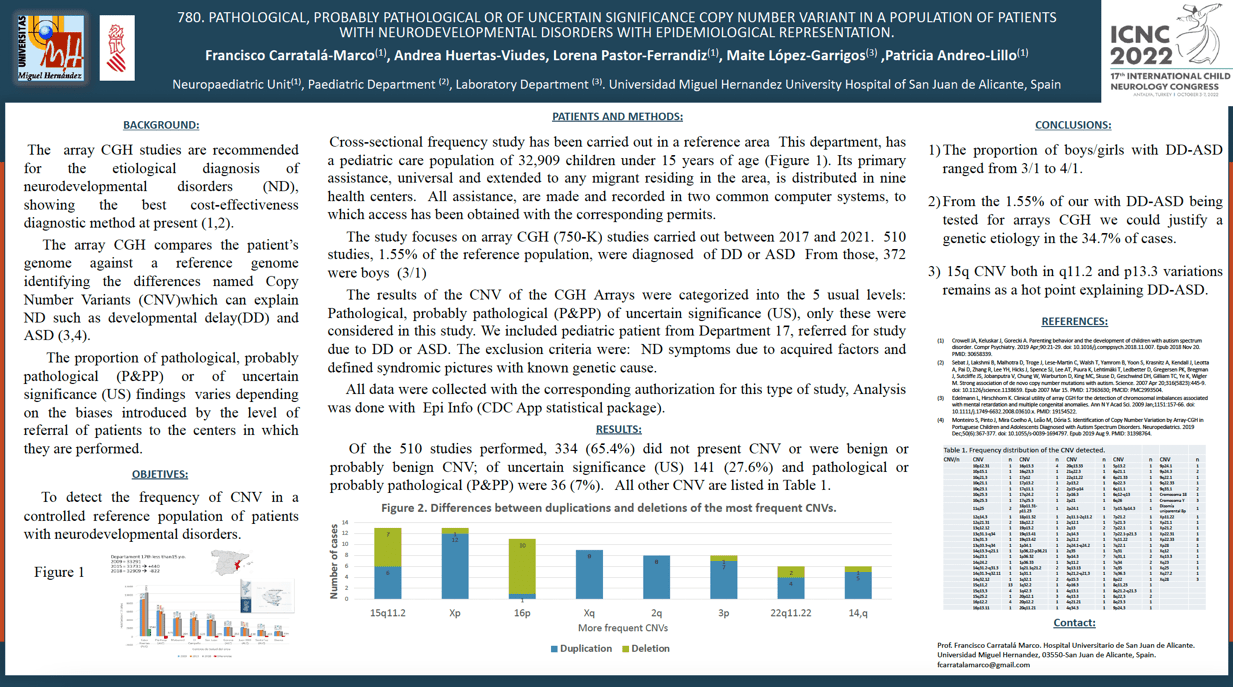PATHOLOGICAL, PROBABLY PATHOLOGICAL OR OF UNCERTAIN SIGNIFICANCE COPY NUMBER VARIANT IN A POPULATION OF PATIENTS WITH NEURODEVELOPMENTAL DISORDERS WITH EPIDEMIOLOGICAL REPRESENTATION.
Francisco Carratalá-Marco, Andrea Huertas-Viudes, Lorena Pastor-Ferrandiz, Patricia Andreo-Lillo, Maite Carratalá-Marco
Background: Microarray studies to detect copy number variants (CNV) are recommended in the initial diagnostic management of patients with neurodevelopmental disorders, especially those diagnosed with ASD and developmental delay. However, the proportion of pathological findings, probably pathological(P&PP) or of uncertain significance (US) that affect these risk groups, varies depending on the biases caused by sending patients severely affected to specialized reference centres. Patients and interventions: Between 2017-2021, we performed 510 750K-microarray studies (372 boys)in patients diagnosed of developmental delay, or ASD(DD-ASD)(1.55%) from a referral population of 32,909 paediatric patients (less than 15 years old) of a public health universal assistance system. Exclusion criteria were to be diagnosed of a genetic illness before the first visit or not to belong to the referral health department. Results: 334(65.4%) were normal, 141(27.6%) were of US and 36(7%) P&PP. The more frequent CNV was 15q11.2 (13; 2.5%) from which 11(2.1%) were considered P&PP. The second was Xp (13; 2.5%) although all of them were considered of US. The 16q (11, 2.1%) where 4(0.7%) were P&PP. Other frequent CNV by frequency order were: Xq; 7q; 2q; 3q; 22q11.; 1q; 14q; 4q; 15p13.3, and affecting Y where all three cases were considered P&PP. Conclusions: 1) From the 1.55% of our referral population with DD-ASD being tested for microarrays, we could justify a genetic aetiology in the 34.7% of cases. 2) 15q variations remains as a hot point explaining DD-ASD. 3) Microarrays still being a useful tool to orientate the aetiological diagnosis DD-ASD patients.
Keywords: CGH-array, ASD, Developmental delay
Francisco Carratalá-Marco
UNIVERSITY HOSPITAL OF SAN JUAN DE ALICANTE
Spain
Andrea Huertas-Viudes
UNIVERSITY HOSPITAL OF SAN JUAN DE ALICANTE
Spain
Lorena Pastor-Ferrandiz
UNIVERSITY HOSPITAL OF SAN JUAN DE ALICANTE
Spain
Patricia Andreo-Lillo
UNIVERSITY HOSPITAL OF SAN JUAN DE ALICANTE
Spain
Maite Carratalá-Marco
UNIVERSITY HOSPITAL OF SAN JUAN DE ALICANTE
Spain
Background: Microarray studies to detect copy number variants (CNV) are recommended in the initial diagnostic management of patients with neurodevelopmental disorders, especially those diagnosed with ASD and developmental delay. However, the proportion of pathological findings, probably pathological(P&PP) or of uncertain significance (US) that affect these risk groups, varies depending on the biases caused by sending patients severely affected to specialized reference centres. Patients and interventions: Between 2017-2021, we performed 510 750K-microarray studies (372 boys)in patients diagnosed of developmental delay, or ASD(DD-ASD)(1.55%) from a referral population of 32,909 paediatric patients (less than 15 years old) of a public health universal assistance system. Exclusion criteria were to be diagnosed of a genetic illness before the first visit or not to belong to the referral health department. Results: 334(65.4%) were normal, 141(27.6%) were of US and 36(7%) P&PP. The more frequent CNV was 15q11.2 (13; 2.5%) from which 11(2.1%) were considered P&PP. The second was Xp (13; 2.5%) although all of them were considered of US. The 16q (11, 2.1%) where 4(0.7%) were P&PP. Other frequent CNV by frequency order were: Xq; 7q; 2q; 3q; 22q11.; 1q; 14q; 4q; 15p13.3, and affecting Y where all three cases were considered P&PP. Conclusions: 1) From the 1.55% of our referral population with DD-ASD being tested for microarrays, we could justify a genetic aetiology in the 34.7% of cases. 2) 15q variations remains as a hot point explaining DD-ASD. 3) Microarrays still being a useful tool to orientate the aetiological diagnosis DD-ASD patients.
Keywords: CGH-array, ASD, Developmental delay
Francisco Carratalá-Marco
UNIVERSITY HOSPITAL OF SAN JUAN DE ALICANTE
Spain
Andrea Huertas-Viudes
UNIVERSITY HOSPITAL OF SAN JUAN DE ALICANTE
Spain
Lorena Pastor-Ferrandiz
UNIVERSITY HOSPITAL OF SAN JUAN DE ALICANTE
Spain
Patricia Andreo-Lillo
UNIVERSITY HOSPITAL OF SAN JUAN DE ALICANTE
Spain
Maite Carratalá-Marco
UNIVERSITY HOSPITAL OF SAN JUAN DE ALICANTE
Spain

Francisco Carratalá-Marco
UNIVERSITY HOSPITAL OF SAN JUAN DE ALICANTE Spain
UNIVERSITY HOSPITAL OF SAN JUAN DE ALICANTE Spain